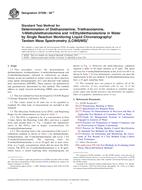Potřebujeme váš souhlas k využití jednotlivých dat, aby se vám mimo jiné mohly ukazovat informace týkající se vašich zájmů. Souhlas udělíte kliknutím na tlačítko „OK“.
ASTM D7599-09e2
Standard Test Method for Determination of Diethanolamine, Triethanolamine, N-Methyldiethanolamine and N-Ethyldiethanolamine in Water by Single Reaction Monitoring Liquid Chromatography/Tandem Mass Sp (Includes all amendments And changes 6/7/2016).
Automaticky přeložený název:
Standardní zkušební metoda pro stanovení diethanolamin, triethanolamin, N-methyldiethanolamin a N-ethyldiethanolamin ve vodě jedné reakci monitorovací kapalinová chromatografie / tandemovou hmotnostní Sp
NORMA vydána dne 1.12.2009
Informace o normě:
Označení normy: ASTM D7599-09e2
Poznámka: NEPLATNÁ
Datum vydání normy: 1.12.2009
Kód zboží: NS-38802
Počet stran: 9
Přibližná hmotnost: 27 g (0.06 liber)
Země: Americká technická norma
Kategorie: Technické normy ASTM
Kategorie - podobné normy:
Anotace textu normy ASTM D7599-09e2 :
Keywords:
ethanolamines, liquid chromatography, mass spectrometry, water, ICS Number Code 13.060.50 (Examination of water for chemical substances)
Doplňující informace
| Significance and Use | ||||||||||||||||
|
N-Ethyldiethanolamine, N-methyldiethanolamine and triethanolamine are Schedule 3 compounds under the Chemical Weapons Convention (CWC). Schedule 3 chemicals include those that have been produced, stockpiled or used as a chemical weapon, poses otherwise a risk to the object and purpose of the CWC because they possess such lethal or incapacitating toxicity as well as other properties that might enable it to be used as a chemical weapon, poses otherwise a risk to the object and purpose of the CWC by virtue of it’s importance in the production of one or more chemicals listed in Schedules 1 or 2, or it may be produced in large commercial quantities for purposes not prohibited under the CWC. Ethanolamines have a broad spectrum of applications. They are used to produce adhesives, agricultural products, cement grinding aids, concrete additives, detergents, specialty cleaners, personal care products, gas treatments, metalwork, oil well chemicals, packaging and printing inks, photographic chemicals, rubber, textile finishing, urethane coatings, textile lubricants, polishes, pesticides, and pharmaceuticals. Ethanolamines are readily dissolved in water, biodegradable and the bio-concentration potential is low. This method has been investigated for use with reagent and surface water. |
||||||||||||||||
| 1. Scope | ||||||||||||||||
|
1.1 This procedure covers the determination of diethanolamine, triethanolamine, N-methyldiethanolamine and N-ethyldiethanolamine (referred to collectively as ethanolamines in this test method) in surface water by direct injection using liquid chromatography (LC) and detected with tandem mass spectrometry (MS/MS). These analytes are qualitatively and quantitatively determined by this method. This method adheres to single reaction monitoring (SRM) mass spectrometry. 1.2 This test method has been developed in support of the National Homeland Security Research Center, US EPA by Region 5 Chicago Regional Laboratory. 1.3 The values stated in SI units are to be regarded as standard. No other units of measurement are included in this standard. 1.4 The Detection Verification Level (DVL) and Reporting Range for the ethanolamines are listed in Table 1. 1.4.1 The DVL is required to be at a concentration at least 3 times below the Reporting Limit (RL) and have a signal/noise ratio greater than 3:1. Fig. 1 displays the signal/noise ratios at the DVLs and at higher concentrations for N-methyldiethanolamine. 1.4.2 The reporting limit is the concentration of the Level 1 calibration standard as shown in Table 2 for diethanolamine, triethanolamine, and N-ethyldiethanolamine and Level 2 for N-methyldiethanolamine. The reporting limit for N-methyldiethanolamine is set at 50 μg/L due to poor sensitivity at a 5 μg/L concentration which did not meet the DVL criteria. The DVL for N-methyldiethanolamine is at 10 μg/L, which forces a raised reporting limit (chromatograms are shown in Fig. 1). However, the multi-laboratory validation required a spike of all target analytes at 25 μg/L. The mean recovery for N-methyldiethanolamine at this level was 88 % as shown in Table 3. If your instrument’s sensitivity can meet the requirements in this test method, N-methyldiethanolamine may have a 25 μg/L reporting limit. 1.5 This standard does not purport to address all of the safety concerns, if any, associated with its use. It is the responsibility of the user of this standard to establish appropriate safety and health practices and determine the applicability of regulatory limitations prior to use. |
||||||||||||||||
| 2. Referenced Documents | ||||||||||||||||
|
Doporučujeme:
Aktualizace zákonů
Chcete mít jistotu o platnosti užívaných předpisů?
Nabízíme Vám řešení, abyste mohli používat stále platné (aktuální) legislativní předpisy.
Chcete vědět více informací? Podívejte se na tuto stránku.




 Cookies
Cookies
